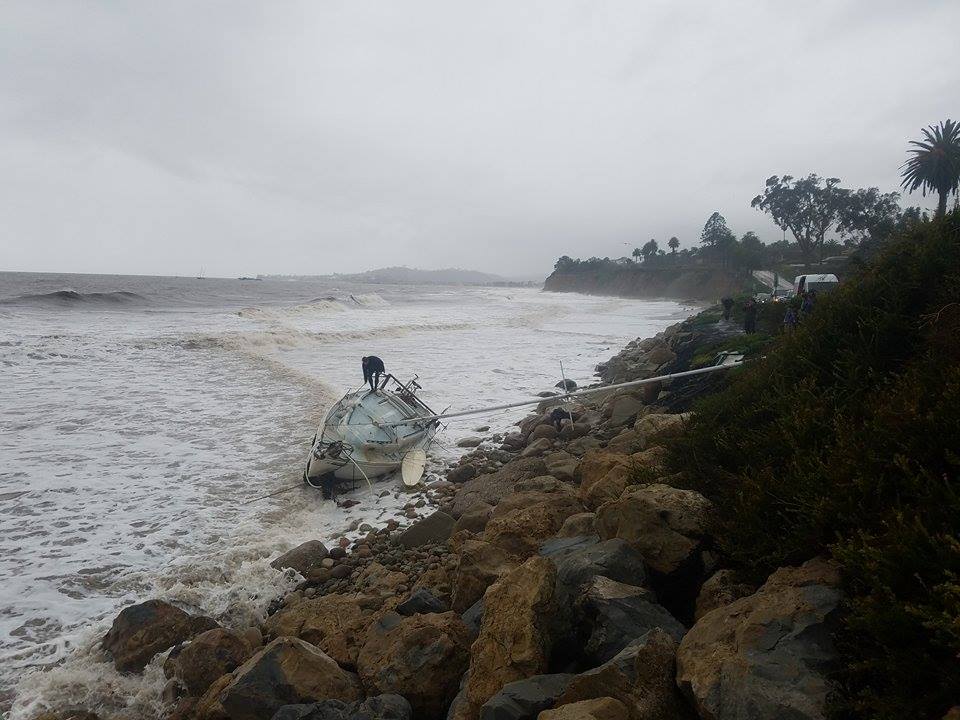The Storm Takes a Home
Tim Kirshtner Lived More Than 20 Years Aboard His Sailboat off Butterfly Beach

The season’s biggest storm plowed through Southern California late last week, choking creeks and rivers, flooding roadways and reservoirs, and agitating the Santa Barbara Channel into a muddy torrent. As high seas and south winds developed in the early morning hours of February 17, the storm’s first casualty — the 30-foot Coronado sailboat Tim Kirshtner called home — washed up on the rocks at Butterfly Beach just up the coast from where it had been anchored for the better part of 21 years.
“[The wind] was only blowing 20 knots that night,” Kirshtner said. “I’m very surprised my boat went to the beach; it’s been through much worse.” He suspects a sudden flip in wind direction caused the anchor lines to snag and fray between the rudder and hull.
Racked by a lingering cough, Kirshtner had spent the night on shore and got the bad news from a friend who had spotted the shipwreck early Friday morning. At the peak of the storm — as Mission Creek reached biblical stature and a century-old stone pine crashed across Anapamu Street — friends and strangers helped unload the boat, saving the radar, outboard motor, and some personal photographs. Most of the rest — waterlogged clothes and bedding, electronics, kitchen and office supplies — was lost. Late Friday, a friend of a friend with a crane hoisted the battered Dream Quest to Channel Drive, where on Saturday morning in another heavy downpour, a handful of fellow watermen winched it into a 40-yard roll-off dumpster.
“I lost my home base,” said Kirshtner, who has organized beach and creek cleanups along the South Coast since he was a kid and now owns and operates the nonprofit Clear Waterways Organization. “I want to focus on saying thank you to my friends and to people I didn’t even know for helping.”
A flip side to the damage can be measured in rain gauges countywide. Since Valentine’s Day, downtown has gathered 7.38 inches of rainfall, and San Marcos Pass over 11 inches. Between Thursday night and Saturday morning last week, two feet of new snow blanketed the upper elevations of Mt. Pinos.
Since September 1, 2016 — the start of the 2016-17 water year — total rainfall downtown is 24.24 inches, already six inches more than the annual average, with more wet weather on the way. The last five years of drought (2012-16) received an average of 10 inches. Preliminary reports from Lake Cachuma state that the reservoir was filling at a peak rate of 25,000 cubic feet of runoff per second, according to Tom Fayram, the county’s deputy director of water resources. “Clearly, we’re having a wet season, but you don’t break a drought with a single storm or even an entire wet season,” he said. As of 8 a.m. on February 22, Cachuma was at 42.4 percent of capacity and filling.
“We haven’t had this much precipitation since 2004,” said Stuart Seto, a weather specialist with the National Weather Service in Oxnard. “And the last time we had those strong south winds was March 2011.” Another storm from the north is expected to show up Sunday afternoon and “most of the rain will be Sunday into Monday,” he added. “But it will be moderate, not near as heavy as the last one.”



